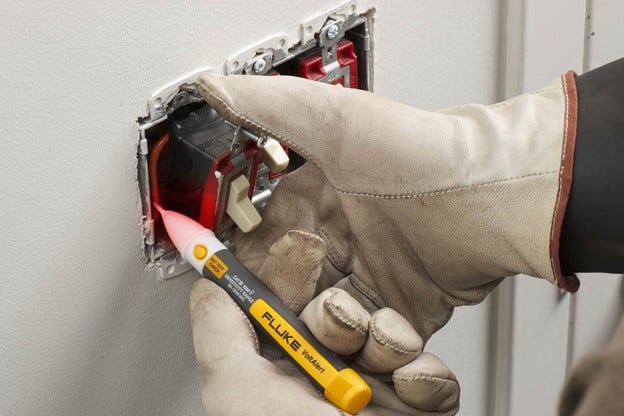A non-contact voltage tester or detector is an electrical tester that helps to detect the presence of voltage. Voltage presence is useful information to have when troubleshooting or working on a failed asset. The first tool you’ll reach for is a non-contact voltage detector.

Fluke non-contact voltage tester detecting voltage
People refer to non-contact voltage testers in many ways. Some synonyms for non-contact voltage tester are:
- Electricity tester pen
- Voltage tester pen
- Non-contact voltage detector
- Voltage detector pen
- AC voltage detector
- Non-contact electrical tester
- Electrical sniffer
- Volt alert tester
- Contactless voltage detector
- Non-contact circuit tester
- Non-contact voltage sensor
- AC tester pen
- No-touch voltage tester
- Proximity voltage tester
- Live wire tester pen
- Non-contact power tester
- Non-contact voltage checker
How do non-contact voltage testers work?
Non-contact voltage testers work by sensing a very small amount of current that is capacitively coupled from the live circuit to the tester and back to ground. Non-contact voltage testers light up when they detect this current without needing to make direct contact.
A built-in sensor at the tip of the tester detects the presence of voltage when touching a conductor, outlet, or supply cord. By holding the tool, you are the ground reference through capacitive coupling. When the tip glows red and the unit beeps, you know voltage is present.
How to use a non-contact voltage tester
To use a non-contact voltage tester you only need to touch the tip of the tester to the wire or, if you’re testing an outlet, the tip of the tester needs to be placed on the faceplate of a smaller plug slot. Most testers will light up and/or make a sound to confirm voltage is present. In the Fluke 1AC II Non-Contact Voltage Tester, the tip glows red and a beeper sounds when voltage is detected.
Before you begin using your non-contact voltage tester, make sure to read and follow the instructions and warnings it came with. Every tester is a little bit different.
To test electrical wires and test if a wire is live, follow these simple steps:
- Verify: place the tip of the non-contact voltage tester on a known live wire or system
- Test: use the tester to check if there’s voltage in the wire or system you need to check
- Check: test against a known voltage source again to ensure the tester’s batteries didn’t empty or that the tester didn’t malfunction during the test
Note: a voltage tester or detector allows you to test a power wire without a multimeter.
Non-contact voltage tester vs multimeter
The difference between a multimeter and a voltage tester is the non-contact voltage tester only detects whether or not voltage is present. A multimeter can tackle many different measurements and tests, including measuring the voltage level on the wire.
Fluke voltage testers
Certified up to CAT IV 1000 V, the Fluke non-contact voltage detectors feature rugged, quality construction and are easy to use. The high reliability you’ve come to expect of Fluke sets these detectors apart and helps ensure your safety. Fluke offers other quality electrical testers. See Fluke’s full line up of electrical testers and voltage continuity testers.
Related Articles
- Best non-contact voltage tester
- Voltage detectors answer your first electrical test question
- A million and one uses for voltage detectors
- IEC Category Ratings
- Fluke 787 vs 789